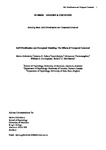Self-prioritization and perceptual matching: The effects of temporal construal.
| dc.contributor.author | Golubickis, M | en |
| dc.contributor.author | Falben, JK | en |
| dc.contributor.author | Sahraie, A | en |
| dc.contributor.author | Visokomogilski, A | en |
| dc.contributor.author | Cunningham, WA | en |
| dc.contributor.author | Sui, J | en |
| dc.contributor.author | Macrae, CN | en |
| dc.date.accessioned | 2020-04-07T10:44:17Z | |
| dc.date.available | 2020-04-07T10:44:17Z | |
| dc.date.issued | 2017-10 | en |
| dc.identifier.uri | http://hdl.handle.net/10026.1/15525 | |
| dc.description.abstract |
Recent research has revealed that self-referential processing enhances perceptual judgments - the so-called self-prioritization effect. The extent and origin of this effect remains unknown, however. Noting the multifaceted nature of the self, here we hypothesized that temporal influences on self-construal (i.e., past/future-self continuity) may serve as an important determinant of stimulus prioritization. Specifically, as representations of the self increase in abstraction as a function of temporal distance (i.e., distance from now), self-prioritization may only emerge when stimuli are associated with the current self. The results of three experiments supported this prediction. Self-relevance only enhanced performance in a standard perceptual-matching task when stimuli (i.e., geometric shapes) were connected with the current self; representations of the self in the future (Expts. 1 & 2) and past (Expt. 3) failed to facilitate decision making. To identify the processes underlying task performance, data were interrogated using a hierarchical drift diffusion model (HDDM) approach. Results of these analyses revealed that self-prioritization was underpinned by a stimulus bias (i.e., rate of information uptake). Collectively, these findings elucidate when and how self-relevance influences decisional processing. | en |
| dc.format.extent | 1223 - 1239 | en |
| dc.language | eng | en |
| dc.language.iso | eng | en |
| dc.subject | Drift diffusion model | en |
| dc.subject | Self | en |
| dc.subject | Social cognition | en |
| dc.subject | Temporal construal | en |
| dc.subject | Adolescent | en |
| dc.subject | Adult | en |
| dc.subject | Decision Making | en |
| dc.subject | Ego | en |
| dc.subject | Female | en |
| dc.subject | Humans | en |
| dc.subject | Male | en |
| dc.subject | Psychomotor Performance | en |
| dc.subject | Social Perception | en |
| dc.subject | Time Factors | en |
| dc.subject | Young Adult | en |
| dc.title | Self-prioritization and perceptual matching: The effects of temporal construal. | en |
| dc.type | Journal Article | |
| plymouth.author-url | https://www.ncbi.nlm.nih.gov/pubmed/28593461 | en |
| plymouth.issue | 7 | en |
| plymouth.volume | 45 | en |
| plymouth.publication-status | Published | en |
| plymouth.journal | Mem Cognit | en |
| dc.identifier.doi | 10.3758/s13421-017-0722-3 | en |
| plymouth.organisational-group | /Plymouth | |
| plymouth.organisational-group | /Plymouth/Faculty of Health | |
| plymouth.organisational-group | /Plymouth/Faculty of Health/School of Psychology | |
| plymouth.organisational-group | /Plymouth/REF 2021 Researchers by UoA | |
| plymouth.organisational-group | /Plymouth/REF 2021 Researchers by UoA/UoA04 Psychology, Psychiatry and Neuroscience | |
| plymouth.organisational-group | /Plymouth/REF 2021 Researchers by UoA/UoA04 Psychology, Psychiatry and Neuroscience/UoA04 Psychology, Psychiatry and Neuroscience MANUAL | |
| plymouth.organisational-group | /Plymouth/Users by role | |
| plymouth.organisational-group | /Plymouth/Users by role/Academics | |
| dc.publisher.place | United States | en |
| dc.identifier.eissn | 1532-5946 | en |
| dc.rights.embargoperiod | Not known | en |
| rioxxterms.versionofrecord | 10.3758/s13421-017-0722-3 | en |
| rioxxterms.licenseref.uri | http://www.rioxx.net/licenses/all-rights-reserved | en |
| rioxxterms.type | Journal Article/Review | en |


